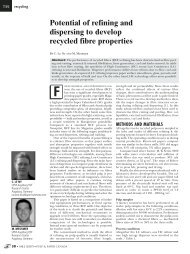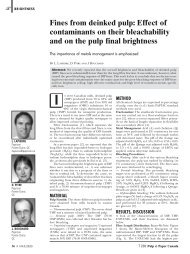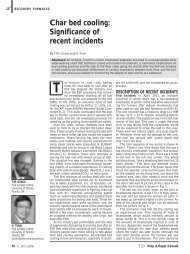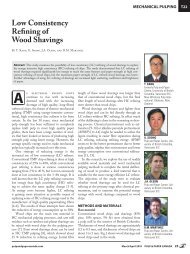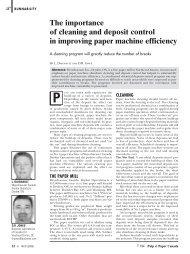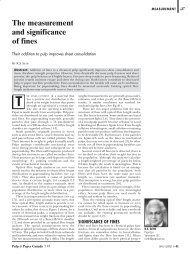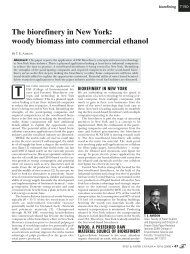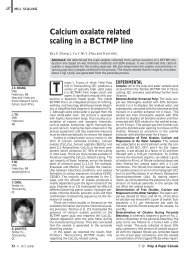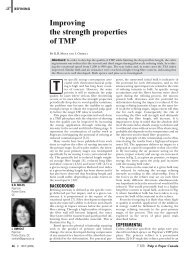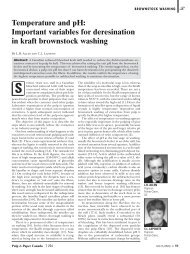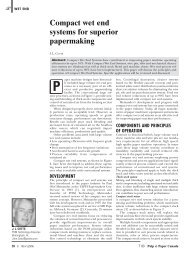Minimizing fouling in spiral heat exchangers at a BCTMP mill
Minimizing fouling in spiral heat exchangers at a BCTMP mill
Minimizing fouling in spiral heat exchangers at a BCTMP mill
Create successful ePaper yourself
Turn your PDF publications into a flip-book with our unique Google optimized e-Paper software.
peer-reviewedT71<strong>M<strong>in</strong>imiz<strong>in</strong>g</strong> <strong>foul<strong>in</strong>g</strong> <strong>in</strong><strong>spiral</strong> <strong>he<strong>at</strong></strong> <strong>exchangers</strong><strong>at</strong> a <strong>BCTMP</strong> <strong>mill</strong>WINNER OF THENATIONAL STUDENTPROBLEM-SOLVINGCOMPETITIONBy M.R. HaqueAbstract: This paper <strong>in</strong>vestig<strong>at</strong>es the cause of calcium oxal<strong>at</strong>e (CaC 2 O 4 ) <strong>foul<strong>in</strong>g</strong> <strong>in</strong> <strong>spiral</strong> <strong>he<strong>at</strong></strong><strong>exchangers</strong>. CaC 2 O 4 solubility decreases with lower<strong>in</strong>g temper<strong>at</strong>ure. The predicted precipit<strong>at</strong>ionr<strong>at</strong>e due to temper<strong>at</strong>ure difference was consistent with the observed <strong>foul<strong>in</strong>g</strong> r<strong>at</strong>e. This observ<strong>at</strong>ionsuggests th<strong>at</strong> the effluent supers<strong>at</strong>ur<strong>at</strong>es and forms precipit<strong>at</strong>e (scale) upon contact with the cold<strong>he<strong>at</strong></strong> exchanger surface. Suspended particles then accumul<strong>at</strong>e and cause rapid <strong>foul<strong>in</strong>g</strong>. This studyrecommends us<strong>in</strong>g physical separ<strong>at</strong>ion methods and partial replacement of NaOH with Mg(OH) 2dur<strong>in</strong>g alkal<strong>in</strong>e bleach<strong>in</strong>g to reduce CaC 2 O 4 content and m<strong>in</strong>imize <strong>foul<strong>in</strong>g</strong>.HEAT EXCHANGER FOULING or scal<strong>in</strong>g aregeneral terms th<strong>at</strong> <strong>in</strong>volve the depositionof extraneous m<strong>at</strong>erial on the<strong>he<strong>at</strong></strong> transfer surface of a <strong>he<strong>at</strong></strong>exchanger. Although both depositscommonly occur together, deposits from <strong>foul<strong>in</strong>g</strong>are known as foulants, whereas deposits fromscal<strong>in</strong>g are known as scales. Scale is a hard m<strong>in</strong>eraldeposit th<strong>at</strong> usually precipit<strong>at</strong>es from thesolution and grows <strong>in</strong> the same place. Foulantsare often high <strong>in</strong> organics and are formed fromsuspended solids <strong>at</strong> a po<strong>in</strong>t other than wherethey deposit. Both types of deposits <strong>in</strong>troduce alayer of <strong>he<strong>at</strong></strong> resistance and reduce the oper<strong>at</strong>ionalcapability of the <strong>he<strong>at</strong></strong> exchanger. In severecases, the deposit can be strong enough to <strong>in</strong>terferewith effluent flow and <strong>in</strong>crease the pressurerequired to ma<strong>in</strong>ta<strong>in</strong> flow r<strong>at</strong>e through the <strong>he<strong>at</strong></strong>exchanger.Deposits of <strong>in</strong>organic salts are a commonproblem <strong>in</strong> domestic, commercial and <strong>in</strong>dustrialprocesses where ‘dirty’ w<strong>at</strong>er is used. Industrializedn<strong>at</strong>ions worldwide annually spend 30 billion$US to deal with this problem [1]. The pulp andpaper sector contributes significantly to thisexpenditure because of the buildup of <strong>in</strong>organicand organic m<strong>at</strong>erials <strong>in</strong> the process w<strong>at</strong>er.Calcium carbon<strong>at</strong>e, calcium oxal<strong>at</strong>e and calciumsulf<strong>at</strong>e are the most persistent scal<strong>in</strong>g components<strong>in</strong> the pulp and paper <strong>in</strong>dustry. Thesecompounds have low solubility products andtend to deposit where abrupt temper<strong>at</strong>ure or pHfluctu<strong>at</strong>ions exist [2]. The effect of temper<strong>at</strong>urechange often makes <strong>he<strong>at</strong></strong> exchanger surfaces idealcandid<strong>at</strong>es for <strong>foul<strong>in</strong>g</strong>. Frequent <strong>foul<strong>in</strong>g</strong> of<strong>he<strong>at</strong></strong> <strong>exchangers</strong> can cause significant fluctu<strong>at</strong>ions<strong>in</strong> plant oper<strong>at</strong>ion and requires both timeand manpower to clean up.In order to take preventive measures to reducethe <strong>foul<strong>in</strong>g</strong> frequency, it is important to identifythe n<strong>at</strong>ure of the scal<strong>in</strong>g component and understandthe <strong>foul<strong>in</strong>g</strong> mechanism. The mechanismsubsequently exposes the rel<strong>at</strong>ionship between<strong>foul<strong>in</strong>g</strong> potential and temper<strong>at</strong>ure, pH or anyother factor <strong>in</strong> the process. This thesis <strong>in</strong>vestig<strong>at</strong>esan exist<strong>in</strong>g <strong>he<strong>at</strong></strong> recovery system loc<strong>at</strong>ed <strong>in</strong>a pulp <strong>mill</strong> which has been plagued with frequent<strong>foul<strong>in</strong>g</strong> problems.BACKGROUNDHigh Yield <strong>BCTMP</strong> MillThe undisclosed pulp <strong>mill</strong> is situ<strong>at</strong>ed <strong>in</strong> Quebec(referred to as ‘pulp <strong>mill</strong>’ henceforth) andemploys a bleached-chemo-thermo-mechanicalpulp<strong>in</strong>g (<strong>BCTMP</strong>) process to convert wood chipsto pulp. This is primarily a mechanical process,with production yields over 80%. Maple, birch oraspen wood are chipped and fed, along withw<strong>at</strong>er, to the ref<strong>in</strong>ers, as shown <strong>in</strong> Fig. 1. In theref<strong>in</strong>ers, chips are converted to fiber under highshear stress and high temper<strong>at</strong>ure. The pulpstream is then washed and passed through a twostagealkal<strong>in</strong>e peroxide bleach<strong>in</strong>g stage. W<strong>at</strong>er ispumped to facilit<strong>at</strong>e the flow of bleach<strong>in</strong>g chemicalsand to wash the bleached pulp <strong>at</strong> the lastpress. The pulp <strong>mill</strong> oper<strong>at</strong>es three highly closedw<strong>at</strong>er loops, as seen <strong>in</strong> Fig. 1. W<strong>at</strong>er is recycledbetween the l<strong>at</strong>ency-wash<strong>in</strong>g, ref<strong>in</strong><strong>in</strong>g-wash<strong>in</strong>g,and wash<strong>in</strong>g-bleach<strong>in</strong>g stages to conserve w<strong>at</strong>erand reduce environmental impact [3]. W<strong>at</strong>er circul<strong>at</strong>ion,however, causes accumul<strong>at</strong>ion of chemicalssuch as oxal<strong>at</strong>e, extractives, lign<strong>in</strong>, hemicelluloses,cellulose, calcium and magnesium. Thesechemicals deposit on downstream equipment (ex:<strong>he<strong>at</strong></strong> <strong>exchangers</strong>) and cause <strong>foul<strong>in</strong>g</strong> problems [3].He<strong>at</strong> Recovery SystemThe <strong>he<strong>at</strong></strong> recovery system was <strong>in</strong>stalled <strong>in</strong> 1994 aspart of the pulp <strong>mill</strong>’s <strong>in</strong>iti<strong>at</strong>ive to recover thermalenergy from the effluent discharged from the<strong>BCTMP</strong> process. The system plays a critical role <strong>in</strong>ma<strong>in</strong>ta<strong>in</strong><strong>in</strong>g the high energy efficiency of the<strong>mill</strong>. The effluent is stored <strong>in</strong> a storage tank, fromthere it is pumped through the three <strong>spiral</strong> <strong>he<strong>at</strong></strong><strong>exchangers</strong> before be<strong>in</strong>g sent to an activ<strong>at</strong>edsludge plant (ASP) for tre<strong>at</strong>ment. A fluctu<strong>at</strong><strong>in</strong>geffluent temper<strong>at</strong>ure between 70°C to 80‡C representsthe potential low grade thermal energyth<strong>at</strong> is recoverable. The <strong>he<strong>at</strong></strong> recovery system alsohelps ma<strong>in</strong>ta<strong>in</strong> the downstream temper<strong>at</strong>urerequired for ASP oper<strong>at</strong>ion.The orig<strong>in</strong>al setup has undergone manychanges to deal with malfunction<strong>in</strong>g equipmentand constant <strong>foul<strong>in</strong>g</strong> problems. The l<strong>at</strong>est setupemploys three <strong>he<strong>at</strong></strong> <strong>exchangers</strong> (HEXs), as shown<strong>in</strong> Fig. 2. Cold river w<strong>at</strong>er <strong>at</strong> seasonal temper<strong>at</strong>ureM.R. HAQUEDepartment of ChemicalEng<strong>in</strong>eer<strong>in</strong>g and AppliedChemistryUniversity of TorontoToronto, ONPULP & PAPER CANADA • 108:4 (2007) • 35
T72scal<strong>in</strong>gFIG. 1. Schem<strong>at</strong>ic of pulp flow <strong>in</strong> <strong>BCTMP</strong> <strong>mill</strong> (modifiedfrom Zhang et al [3]).FIG. 2. Effluent flow configur<strong>at</strong>ion through the <strong>he<strong>at</strong></strong><strong>exchangers</strong> (HEXs) <strong>in</strong> the recovery system.FIG. 3. Internals of a <strong>spiral</strong> <strong>he<strong>at</strong></strong> exchanger [5].FIG. 4. Dried hard Scale sample.is used as the coolant liquid. The <strong>he<strong>at</strong></strong>ed river w<strong>at</strong>er is then sentto the <strong>mill</strong> for use.The three <strong>he<strong>at</strong></strong> <strong>exchangers</strong> <strong>at</strong> this <strong>mill</strong> are refurbished <strong>spiral</strong>units manufactured <strong>in</strong> 1973. The orig<strong>in</strong>al manufacturer wasAmerican He<strong>at</strong> Reclaim<strong>in</strong>g Corpor<strong>at</strong>ion (AHRC), which hass<strong>in</strong>ce been bought by Alfa Laval Inc. Orig<strong>in</strong>ally one of the <strong>he<strong>at</strong></strong><strong>exchangers</strong> was a larger unit, and hence two smaller <strong>he<strong>at</strong></strong><strong>exchangers</strong> were arranged <strong>in</strong> series to have comparable effect.In 2004, however, the larger <strong>he<strong>at</strong></strong> exchanger broke down andwas replaced with a smaller AHRC unit.Spiral <strong>he<strong>at</strong></strong> <strong>exchangers</strong> are made of two fl<strong>at</strong> pl<strong>at</strong>es, which arewrapped around each other to cre<strong>at</strong>e two concentric channelsof rectangular cross section. The warm effluent and cool<strong>in</strong>gw<strong>at</strong>er flow <strong>in</strong> countercurrent direction, Fig. 3, maximiz<strong>in</strong>g the<strong>he<strong>at</strong></strong> transfer efficiency [4,5].The rectangular s<strong>in</strong>gle channel geometry means th<strong>at</strong> thecross-sectional area decreases with settl<strong>in</strong>g solids, <strong>in</strong>creas<strong>in</strong>gvelocity of the effluent. Accord<strong>in</strong>g to Alfa Laval, the high velocitysweeps and removes the settled solids. This <strong>in</strong>creases theamount of solid th<strong>at</strong> can be present <strong>in</strong> the effluent without <strong>foul<strong>in</strong>g</strong>up the <strong>he<strong>at</strong></strong> exchanger [4,5]. For this reason, <strong>spiral</strong> <strong>he<strong>at</strong></strong><strong>exchangers</strong> have been employed <strong>in</strong> <strong>foul<strong>in</strong>g</strong> prone applic<strong>at</strong>ionssuch as PVC slurry, oleum-process<strong>in</strong>g etc. A decrease <strong>in</strong> channelspac<strong>in</strong>g, however, decreases the maximum solids concentr<strong>at</strong>ionth<strong>at</strong> can be handled by the <strong>he<strong>at</strong></strong> exchanger. It is possible th<strong>at</strong><strong>in</strong>adequ<strong>at</strong>e spac<strong>in</strong>g is a reason for <strong>foul<strong>in</strong>g</strong> <strong>in</strong> the AHRC <strong>he<strong>at</strong></strong><strong>exchangers</strong>.The <strong>spiral</strong> <strong>he<strong>at</strong></strong> <strong>exchangers</strong> have been experienc<strong>in</strong>g severe<strong>foul<strong>in</strong>g</strong> problems s<strong>in</strong>ce <strong>in</strong>stall<strong>at</strong>ion. The pulp <strong>mill</strong> has observedthe form<strong>at</strong>ion of porcela<strong>in</strong> like hard scales on the surface of the<strong>he<strong>at</strong></strong> exchanger. It has also been observed th<strong>at</strong> fiber, particul<strong>at</strong>em<strong>at</strong>ter and other foulants also deposit on the scale, eventuallyblock<strong>in</strong>g up the <strong>he<strong>at</strong></strong> exchanger, Fig. 4.Every time a <strong>he<strong>at</strong></strong> exchanger blocks up, it has to be bypassedand blasted with high-pressure w<strong>at</strong>er for scale removal. Thisresults <strong>in</strong> a loss of <strong>he<strong>at</strong></strong> transfer by the system. It has been estim<strong>at</strong>edth<strong>at</strong> $400,000+ has been spent to improve the system withthe <strong>in</strong>tention of reduc<strong>in</strong>g <strong>foul<strong>in</strong>g</strong> r<strong>at</strong>e. Major work has been doneto direct the effluent flow to a storage tank to ma<strong>in</strong>ta<strong>in</strong> stable andconstant flow r<strong>at</strong>e. Despite the significant <strong>in</strong>vestment and effort,the rapid <strong>foul<strong>in</strong>g</strong> problem rema<strong>in</strong>s. It has also been noted th<strong>at</strong>HEX 5, as seen <strong>in</strong> Fig. 5 before and after clean<strong>in</strong>g, has been <strong>foul<strong>in</strong>g</strong>up more often than the other two HEXs <strong>in</strong> the <strong>mill</strong>. A thoroughunderstand<strong>in</strong>g of the cause of <strong>foul<strong>in</strong>g</strong> has yet to be determ<strong>in</strong>ed.Hence, a suitable solution to the problem still awaits.Previous Scale AnalysisIn order to determ<strong>in</strong>e the <strong>in</strong>organic composition of the scale, X-ray fluorescence spectroscopy was performed after ash<strong>in</strong>g driedscale samples. Table I displays the results of the scale analysisperformed <strong>in</strong> 1998. It is seen th<strong>at</strong> the <strong>in</strong>organic portion of thedeposits is ma<strong>in</strong>ly calcium salts. It was also found th<strong>at</strong> calciumoxal<strong>at</strong>e (CaC 2 O 4 ) was the major form of calcium salt present <strong>in</strong>the sample. The analysis was showed th<strong>at</strong> 70.4% of the depositwas made of calcium oxal<strong>at</strong>e.Additionally, calcium oxal<strong>at</strong>e deposits have also been found<strong>at</strong> other po<strong>in</strong>ts <strong>in</strong> the pulp <strong>mill</strong>. A study of calcium oxal<strong>at</strong>edeposits has been performed <strong>in</strong> the disc filter shower and rejectspress samples by Zhang et al [3]. This study provides a mechanismfor the form<strong>at</strong>ion of calcium oxal<strong>at</strong>e <strong>in</strong> a <strong>BCTMP</strong> <strong>mill</strong>. Relevantresults from this study have been <strong>in</strong>cluded <strong>in</strong> this thesis,which specifically tries to determ<strong>in</strong>e the cause of scal<strong>in</strong>g <strong>in</strong> the<strong>spiral</strong> <strong>he<strong>at</strong></strong> <strong>exchangers</strong>.OBJECTIVESThe overall objective of this thesis is to determ<strong>in</strong>e the cause of<strong>foul<strong>in</strong>g</strong> <strong>in</strong> the <strong>spiral</strong> <strong>he<strong>at</strong></strong> <strong>exchangers</strong> and suggest practical measuresto reduce form<strong>at</strong>ion of scale. Understand<strong>in</strong>g the <strong>foul<strong>in</strong>g</strong>mechanism would help identify effective solutions. The breakdownof objectives is as follows:a) Characterize the n<strong>at</strong>ure of the scale depositsb) Once the scale composition has been identified, specul<strong>at</strong>eon the mechanism of scale form<strong>at</strong>ionc) Identify possible upstream processes, oper<strong>at</strong><strong>in</strong>g conditions or36 • 108:4 (2007) • PULP & PAPER CANADA
T74scal<strong>in</strong>gum oxal<strong>at</strong>e <strong>in</strong> the scale is estim<strong>at</strong>ed by thefollow<strong>in</strong>g calcul<strong>at</strong>ion.CaC 2 O 4 (s)—— CaO(s) + CO 2 (g) + CO(g)(Overall decomposition reaction)Mol. Mass (g/mol) 128 56 44 28Us<strong>in</strong>g a basis of 1 mole (128gm) of sample,Theoretical mass loss % dur<strong>in</strong>g totaldecomposition:Mass of Gas Evapor<strong>at</strong>ed—————————— 100% =Total Mass of Sample(44 + 28)gm—————— 100% = 56%128gmActual mass loss % from thermal analysisexperiment, Fig. 11: Step 2 + Step 3:FIG. 6. Positions of sample scale collection.FIG. 7. Pulp <strong>mill</strong> effluent.Mass of Gas Evapor<strong>at</strong>ed—————————— 100% = 49%Total Mass of SamplePercentage of calcium oxal<strong>at</strong>e =49—— 100% = 87.5%56Calcium oxal<strong>at</strong>e has three differenthydr<strong>at</strong>ed forms: monohydr<strong>at</strong>e, dihydr<strong>at</strong>eand trihydr<strong>at</strong>e. Monohydr<strong>at</strong>e is the moststable and has the lowest solubility [2].Thus it can be specul<strong>at</strong>ed th<strong>at</strong> calciumoxal<strong>at</strong>e monohydr<strong>at</strong>e (CaC 2 O 4 .H 2 O) isthe ma<strong>in</strong> component (87.5%) of the <strong>he<strong>at</strong></strong>exchanger deposit. The study by Zhang etal. also showed th<strong>at</strong> the pulp <strong>mill</strong> disc-filtershower and reject press had calciumoxal<strong>at</strong>e deposition [3]. This suggests th<strong>at</strong>the <strong>mill</strong> has been experienc<strong>in</strong>g calciumoxal<strong>at</strong>e scal<strong>in</strong>g problems elsewhere <strong>in</strong> thesystem and thus it is likely th<strong>at</strong> <strong>in</strong> the <strong>he<strong>at</strong></strong><strong>exchangers</strong>, the scale type is <strong>in</strong>deed calciumoxal<strong>at</strong>e.Determ<strong>in</strong><strong>in</strong>g Foul<strong>in</strong>g R<strong>at</strong>eOnce the type of scale has been determ<strong>in</strong>ed,the next step <strong>in</strong>volves quantify<strong>in</strong>g<strong>foul<strong>in</strong>g</strong> r<strong>at</strong>e based on a few simplifiedassumptions. The flow r<strong>at</strong>e trends over aone-year period through HEX 3 & 5 andthrough HEX 4 are plotted <strong>in</strong> Figs. 12and 13.The flow r<strong>at</strong>e trend shows the extent ofthe <strong>foul<strong>in</strong>g</strong> problem <strong>in</strong> the pulp <strong>mill</strong>.Maximum flow is achieved immedi<strong>at</strong>elyafter high pressure clean<strong>in</strong>g. Then thescal<strong>in</strong>g m<strong>at</strong>erial and foulants beg<strong>in</strong> todeposit and slowly reduce the flow r<strong>at</strong>e,eventually plugg<strong>in</strong>g up the <strong>he<strong>at</strong></strong> exchanger.The deposit build-up reduces the flowchannel area. This <strong>in</strong>creases the pressuredrop across each <strong>he<strong>at</strong></strong> exchanger andreduces the flow r<strong>at</strong>e through the system.The change <strong>in</strong> flow r<strong>at</strong>e over time isthus a function of <strong>foul<strong>in</strong>g</strong> r<strong>at</strong>e. A faster<strong>foul<strong>in</strong>g</strong> r<strong>at</strong>e leads to a steep decrease <strong>in</strong>flow. Subsequently a slower <strong>foul<strong>in</strong>g</strong> r<strong>at</strong>etakes longer to affect flow. The change <strong>in</strong>flow r<strong>at</strong>e over time, the slope <strong>in</strong> Figs. 12and 13, can thus be used to estim<strong>at</strong>e <strong>foul<strong>in</strong>g</strong>r<strong>at</strong>e.FIG. 8. Schem<strong>at</strong>ic of procedure to measure level of s<strong>at</strong>ur<strong>at</strong>ion of effluent solution.d(flowr<strong>at</strong>e)—————— = f(Foul<strong>in</strong>g r<strong>at</strong>e)dtThe follow<strong>in</strong>g assumptions are made<strong>in</strong> order to quantify the <strong>foul<strong>in</strong>g</strong> r<strong>at</strong>e.• The <strong>spiral</strong> <strong>he<strong>at</strong></strong> exchanger surface isfl<strong>at</strong>tened <strong>in</strong>to a rectangular cross section,Fig. 14• Effluent velocity rema<strong>in</strong>s constant overtime• The <strong>foul<strong>in</strong>g</strong> r<strong>at</strong>e is constant over timeFor a constant velocity, the volumetricflow r<strong>at</strong>e is def<strong>in</strong>ed asVolumetric Flowr<strong>at</strong>e =Velocity Unblocked AreaThe maximum flow occurs <strong>at</strong> time = 0,when the deposit thickness (t) = 0 andchannel spac<strong>in</strong>g (b) = 15.875mm (<strong>he<strong>at</strong></strong>exchanger <strong>in</strong>ner channel). As time <strong>in</strong>creases,the t is <strong>in</strong>creased by a constant value(<strong>foul<strong>in</strong>g</strong> r<strong>at</strong>e) until the channel completelyblocks up. The <strong>foul<strong>in</strong>g</strong> r<strong>at</strong>e th<strong>at</strong> bestm<strong>at</strong>ches the actual flow r<strong>at</strong>e profile withthe theoretical profile, shown <strong>in</strong> Fig. 15, isselected as the correct estim<strong>at</strong>ed <strong>foul<strong>in</strong>g</strong>r<strong>at</strong>e. The same tre<strong>at</strong>ment is applied to analyze<strong>in</strong>dividual slopes for all d<strong>at</strong>a. The averageresults are presented <strong>in</strong> Table II.It is seen th<strong>at</strong> the series arrangementof HEX 3 and 5 foul up faster than HEX4. This agrees with <strong>mill</strong> observ<strong>at</strong>ions th<strong>at</strong>they have to clean HEX 5 more often. It isalso seen th<strong>at</strong> the <strong>foul<strong>in</strong>g</strong> r<strong>at</strong>e throughHEX 3 & 5 <strong>in</strong>creased after April 2005 andthe average maximum flow after scaleremoval decreased after April 2005, notethe boxed area <strong>in</strong> Fig. 12.Both observ<strong>at</strong>ions suggest th<strong>at</strong> the <strong>he<strong>at</strong></strong>exchanger cleanup procedure waschanged <strong>in</strong> April 2005, <strong>in</strong>versely affect<strong>in</strong>gthe <strong>he<strong>at</strong></strong> exchanger performance. Thepulp <strong>mill</strong> confirmed th<strong>at</strong>, before April, anexternal company cleaned the <strong>he<strong>at</strong></strong><strong>exchangers</strong> with a high-pressure w<strong>at</strong>erhose. S<strong>in</strong>ce April, the clean<strong>in</strong>g has beendone <strong>in</strong>ternally with a lower pressure hoseto reduce oper<strong>at</strong><strong>in</strong>g expenses. The effectof <strong>in</strong>efficient clean<strong>in</strong>g thus had significantimpact on <strong>foul<strong>in</strong>g</strong> r<strong>at</strong>e. This is discussed<strong>in</strong> detail <strong>in</strong> a l<strong>at</strong>er section.Calcium Oxal<strong>at</strong>e Form<strong>at</strong>ionOnce it is confirmed th<strong>at</strong> there is excesscalcium oxal<strong>at</strong>e pass<strong>in</strong>g through the <strong>he<strong>at</strong></strong>recovery system, it is important to determ<strong>in</strong>ethe source of the calcium andoxal<strong>at</strong>e ions <strong>in</strong> the <strong>BCTMP</strong> process.Zhang et al. have done significant workon the form<strong>at</strong>ion of oxal<strong>at</strong>e <strong>in</strong> a <strong>BCTMP</strong><strong>mill</strong> with a similar configur<strong>at</strong>ion to ourpulp <strong>mill</strong> [3]. They have <strong>in</strong>vestig<strong>at</strong>ed the<strong>BCTMP</strong> process and identified 3 sourcesof oxal<strong>at</strong>e: <strong>in</strong>put with wood, ref<strong>in</strong><strong>in</strong>g stageand bleach<strong>in</strong>g stage.38 • 108:4 (2007) • PULP & PAPER CANADA
peer-reviewedT75FIG. 9. D<strong>at</strong>a po<strong>in</strong>ts available around the He<strong>at</strong> RecoverySystem.FIG. 10. Thermograph for decomposition of pure calciumoxal<strong>at</strong>e monohydr<strong>at</strong>e.FIG. 11. Thermograph for decomposition of scale sampledried <strong>at</strong> 85°C from HEX5. FIG. 12. Flow trend through HEX 3 & 5.Their work shows th<strong>at</strong> the <strong>in</strong>put withwood and the ref<strong>in</strong><strong>in</strong>g stage contributedsmall amounts of oxal<strong>at</strong>e. However, a significantamount was formed dur<strong>in</strong>g peroxidebleach<strong>in</strong>g. Other researchers havealso confirmed peroxide bleach<strong>in</strong>g as amajor oxal<strong>at</strong>e source <strong>in</strong> <strong>BCTMP</strong> <strong>mill</strong>s[9,12]. The mechanism of form<strong>at</strong>ion hasbeen described as an <strong>at</strong>tack of hydrogenperoxide (H 2 O 2 ) on oxal<strong>at</strong>e precursors(OP) present with fiber <strong>in</strong> the pulp solution(Fiber-OP). Fiber-OP exists as Fiber-OP-H + , which is <strong>in</strong> equilibrium with Ca 2+ions to form Fiber-OP-Ca 2+ . Ca 2+ ionsenter the <strong>BCTMP</strong> process with hard w<strong>at</strong>erand wood. The oxid<strong>at</strong>ion of Fiber-OP withH 2 O 2 produces oxal<strong>at</strong>es. The reactioncha<strong>in</strong> is summarized <strong>in</strong> Fig. 16 [3].Effect of Temper<strong>at</strong>ureIt is well known th<strong>at</strong> crystals formed <strong>in</strong> onepart of a system and carried elsewhere areless adherent than those crystals formedon site. Therefore, a change of oper<strong>at</strong><strong>in</strong>gcondition th<strong>at</strong> leads to precipit<strong>at</strong>ion with<strong>in</strong>the <strong>he<strong>at</strong></strong> <strong>exchangers</strong> is wh<strong>at</strong> causes stablescale form<strong>at</strong>ion. For a <strong>he<strong>at</strong></strong> exchanger,temper<strong>at</strong>ure is most likely the key factorth<strong>at</strong> would <strong>in</strong>fluence scal<strong>in</strong>g.Figure 17 shows the solubility curve forcalcium oxal<strong>at</strong>e. The solubility values areobta<strong>in</strong>ed from various sources compiled<strong>in</strong> the solubility handbook [10]. The d<strong>at</strong>apo<strong>in</strong>ts can be fit with a straight l<strong>in</strong>e, suggest<strong>in</strong>ga l<strong>in</strong>ear rel<strong>at</strong>ionship between temper<strong>at</strong>ureand solubility. Thus, contact witha lower temper<strong>at</strong>ure surface would reducethe solubility of calcium oxal<strong>at</strong>e and thenprecipit<strong>at</strong>e solids, caus<strong>in</strong>g build up ofscale. The equ<strong>at</strong>ion of the solubility-temper<strong>at</strong>uregraph is as follows.Solubility (g/L) = 0.0001Temp(°C)+0.0051The solubility graph can be used todeterm<strong>in</strong>e the precipit<strong>at</strong>ion amountbased on the temper<strong>at</strong>ure difference. Thed<strong>at</strong>a for temper<strong>at</strong>ure difference is presented<strong>in</strong> Fig. 18.Table III displays the precipit<strong>at</strong>ionr<strong>at</strong>es formed across each <strong>he<strong>at</strong></strong> exchanger.Us<strong>in</strong>g the temper<strong>at</strong>ure-solubility rel<strong>at</strong>ionship,the temper<strong>at</strong>ure difference acrosseach <strong>he<strong>at</strong></strong> exchanger is converted to a solubilitydifference value. Maximum flowr<strong>at</strong>e is assumed to be 2100L/m<strong>in</strong>, fromthe average maximum flows achieved,Figs. 12 and 13.Precipit<strong>at</strong>ion R<strong>at</strong>e = Solubility Flowr<strong>at</strong>eFrom the last column <strong>in</strong> Table III, itcan be seen th<strong>at</strong> HEX 5 has the highestprecipit<strong>at</strong>ion r<strong>at</strong>e. This once aga<strong>in</strong> agreeswith the <strong>mill</strong> observ<strong>at</strong>ion th<strong>at</strong> HEX 5needs to be cleaned more frequently. Toconfirm if the effect of temper<strong>at</strong>ure is significant,a theoretical <strong>foul<strong>in</strong>g</strong> r<strong>at</strong>e is calcul<strong>at</strong>ed,based on estim<strong>at</strong>es of <strong>foul<strong>in</strong>g</strong>r<strong>at</strong>es calcul<strong>at</strong>ed earlier.Foul<strong>in</strong>g r<strong>at</strong>e (kg/day) = Exposed Surface AreaFoul<strong>in</strong>g R<strong>at</strong>e (mm/day) Foulant DensityExposed Surface Area = 90.9 m 2Foul<strong>in</strong>g R<strong>at</strong>e = 0.07 mm/day, from TableII, HEX 4Density is assumed to be 1500 kg/m 3based on the visible structure of deposits,which appears to have the same structureas clay. Typical clay density is 1500 kg/m 3 .Us<strong>in</strong>g the above d<strong>at</strong>a, theoretical <strong>foul<strong>in</strong>g</strong>r<strong>at</strong>e for HEX 4 is found to be 9.54 kg/day.HEX 4 was considered because it is theonly HEX <strong>in</strong> its l<strong>in</strong>e. The series arrangementon the other l<strong>in</strong>e makes it difficultto rel<strong>at</strong>e flow r<strong>at</strong>e and <strong>foul<strong>in</strong>g</strong> r<strong>at</strong>e.The underly<strong>in</strong>g assumption <strong>in</strong> estim<strong>at</strong><strong>in</strong>g<strong>foul<strong>in</strong>g</strong> r<strong>at</strong>e based on flow r<strong>at</strong>e gradientsis th<strong>at</strong> deposit builds up uniformlyacross the entire <strong>he<strong>at</strong></strong> exchanger surface.The <strong>foul<strong>in</strong>g</strong> r<strong>at</strong>e estim<strong>at</strong>ed from the flowr<strong>at</strong>e gradient ignores the fact th<strong>at</strong> depositedsolids <strong>at</strong> a s<strong>in</strong>gle po<strong>in</strong>t along the effluentflow channel are sufficient to constrictthe flow. In reality, the deposit form<strong>at</strong>ionis not uniform. This is visible <strong>in</strong> Fig. 19.The real <strong>foul<strong>in</strong>g</strong> r<strong>at</strong>e is thus significantlylower than 9.54 kg/day. The overestim<strong>at</strong>ed<strong>foul<strong>in</strong>g</strong> r<strong>at</strong>e of 9.54 kg/day howeverprovides a frame of reference for comparisonwith the precipit<strong>at</strong>ion r<strong>at</strong>e due totemper<strong>at</strong>ure difference across HEX 4,which is 4.35 kg/day.From previous calcul<strong>at</strong>ions, Table III, itwas found th<strong>at</strong> 4.35 kg/day of calciumoxal<strong>at</strong>e precipit<strong>at</strong>ed due to the change <strong>in</strong>PULP & PAPER CANADA • 108:4 (2007) • 39
T76scal<strong>in</strong>gFIG. 13. Flow trend through HEX 4.FIG. 14. Cross section of fl<strong>at</strong>tened <strong>he<strong>at</strong></strong> exchanger channel.FIG. 16. Calcium oxal<strong>at</strong>e form<strong>at</strong>ion dur<strong>in</strong>g peroxide bleach<strong>in</strong>g(Adapted from Zhang et al).TABLE II. Summary of <strong>foul<strong>in</strong>g</strong> r<strong>at</strong>e through <strong>he<strong>at</strong></strong> recoverysystem.He<strong>at</strong>He<strong>at</strong>Exchanger Exchanger3 & 5 4FIG. 15. Comparison of theoretical flow r<strong>at</strong>e trend andactual flow r<strong>at</strong>e trend through HEX 3 & 5.calcium oxal<strong>at</strong>e solubility with decreas<strong>in</strong>g temper<strong>at</strong>ure acrossHEX 4. The proximity of 4.35 kg/day precipit<strong>at</strong>ion r<strong>at</strong>e and 9.54kg/day theoretical <strong>foul<strong>in</strong>g</strong> r<strong>at</strong>e suggest th<strong>at</strong> it is possible th<strong>at</strong>temper<strong>at</strong>ure difference drastically affects calcium oxal<strong>at</strong>e <strong>foul<strong>in</strong>g</strong>.The difference between the precipit<strong>at</strong>ion r<strong>at</strong>e and the <strong>foul<strong>in</strong>g</strong>r<strong>at</strong>e could be also expla<strong>in</strong>ed by:• The effect of suspended particles. The effluent conta<strong>in</strong>s significantamount of suspended particles, fibers, etc., Fig. 7. These suspendedsolids are likely to contribute to <strong>foul<strong>in</strong>g</strong> and account fora significant portion of the difference between the two numbers.• The analysis uses average values to estim<strong>at</strong>e the temper<strong>at</strong>uredifference. Temper<strong>at</strong>ure fluctu<strong>at</strong>ions <strong>in</strong> the actual process couldresult <strong>in</strong> faster deposition of solids.The fact th<strong>at</strong> these numbers are not off by orders of magnitudesuggests th<strong>at</strong> temper<strong>at</strong>ure difference has a significant effecton the <strong>foul<strong>in</strong>g</strong> r<strong>at</strong>e. The next step is to characterize the level ofcalcium oxal<strong>at</strong>e s<strong>at</strong>ur<strong>at</strong>ion, which leads to the follow<strong>in</strong>g analysis.Effect of S<strong>at</strong>ur<strong>at</strong>ion LevelSeveral researchers have highlighted the importance of s<strong>at</strong>ur<strong>at</strong>ionlevel on the scal<strong>in</strong>g mechanism [11,12,13]. The procedureto determ<strong>in</strong>e s<strong>at</strong>ur<strong>at</strong>ion level and the amount of suspended calciumoxal<strong>at</strong>e <strong>in</strong> the effluent was detailed <strong>in</strong> an earlier section ofD<strong>at</strong>a Analysis Units Before After Nov 04-April 05 April 05 Apr 05Flow after cleanup (max) l/hr 2100 1230 2100R<strong>at</strong>e of flowdecrese (L/hr)/day 40 90 20Foul<strong>in</strong>g R<strong>at</strong>e mm/day 0.14 0.3 0.07Time to completeblockage # of days 53 12 105this paper. Results are presented <strong>in</strong> Table IV.Table IV shows th<strong>at</strong> the effluent has a high quantity of suspendedcalcium oxal<strong>at</strong>e particles. The presence of suspendedcalcium oxal<strong>at</strong>e particles suggests th<strong>at</strong> the effluent is s<strong>at</strong>ur<strong>at</strong>edwith calcium oxal<strong>at</strong>e. Therefore, the solubility graph of calciumoxal<strong>at</strong>e can be used to determ<strong>in</strong>e the dissolved concentr<strong>at</strong>ion.The amount of suspended calcium oxal<strong>at</strong>e content is 72 timesgre<strong>at</strong>er than the dissolved content. This means th<strong>at</strong> the effluentis highly s<strong>at</strong>ur<strong>at</strong>ed.It was earlier mentioned th<strong>at</strong> suspended particles from one partof the system carried elsewhere are less adherent than those particlesformed on the same spot. However, once the deposit forms, itis likely th<strong>at</strong> the bombardment of suspended particles will <strong>in</strong>jectadditional mass <strong>in</strong>to the scale and cause rapid <strong>foul<strong>in</strong>g</strong>, Fig. 20.Undissolved Calcium Oxal<strong>at</strong>e Particle Flow = Particle Desnisty MaximumFlow0.90(g/L) 2100(L/m<strong>in</strong>) ÷ 1000(kg/g) 1440(m<strong>in</strong>/day) =2700(kg/day)Approxim<strong>at</strong>ely 2.7 tonnes of calcium oxal<strong>at</strong>e <strong>in</strong> suspendedparticles are pass<strong>in</strong>g through the <strong>he<strong>at</strong></strong> exchanger every day. Thisis a r<strong>at</strong>her high number and, even if a fraction of this mass<strong>at</strong>taches to the scale, the contribution to <strong>foul<strong>in</strong>g</strong> would be sig-40 • 108:4 (2007) • PULP & PAPER CANADA
peer-reviewedT77FIG. 18. Average temper<strong>at</strong>ure d<strong>at</strong>a across <strong>in</strong>dividual <strong>he<strong>at</strong></strong><strong>exchangers</strong>.FIG. 17. Change <strong>in</strong> solubility with solution temper<strong>at</strong>ure forcalcium oxal<strong>at</strong>e monohydr<strong>at</strong>e.FIG. 20. Contribution of suspended particles to deposit form<strong>at</strong>ion.TABLE III. Precipit<strong>at</strong>ion r<strong>at</strong>es due to temper<strong>at</strong>ure differenceacross each <strong>he<strong>at</strong></strong> exchanger.Temp Temp T Solubility Max. Precip.In Out Flow R<strong>at</strong>eCelcius Celcius Celcius g/L L/m<strong>in</strong> kg/dayHEX 4 81 67 14 0.0014 2100 4.35HEX 3 81 75 6 0.0006 2100 1.84HEX 5 75 59 16 0.0016 2100 4.72FIG. 19. Close-up of <strong>he<strong>at</strong></strong> exchanger non-uniform deposit.nificant. The overall high calcium oxal<strong>at</strong>e content <strong>in</strong> effluentmeans th<strong>at</strong> it is highly prone to <strong>foul<strong>in</strong>g</strong>.Proposed Foul<strong>in</strong>g MechanismSo far the sources of calcium oxal<strong>at</strong>e have been identified andthe effect of temper<strong>at</strong>ure and s<strong>at</strong>ur<strong>at</strong>ion level established. Theresults suggest the follow<strong>in</strong>g <strong>foul<strong>in</strong>g</strong> mechanism tak<strong>in</strong>g place.The pulp <strong>mill</strong> conta<strong>in</strong>s three highly closed w<strong>at</strong>er loops. Thecont<strong>in</strong>uous recircul<strong>at</strong>ion of w<strong>at</strong>er builds up organic and <strong>in</strong>organicchemicals and thus the dissolved ions are s<strong>at</strong>ur<strong>at</strong>ed. S<strong>at</strong>ur<strong>at</strong>ionof calcium and oxal<strong>at</strong>e ions was confirmed while characteriz<strong>in</strong>gthe effluent. The mechanism beg<strong>in</strong>s with the calciumand oxal<strong>at</strong>e ions dissolv<strong>in</strong>g <strong>in</strong> the solution.A key factor <strong>in</strong> scale form<strong>at</strong>ion is supers<strong>at</strong>ur<strong>at</strong>ion to the po<strong>in</strong>tof crystalliz<strong>at</strong>ion. This is regarded as the primary cause of scal<strong>in</strong>g[8]. Various researchers have shown th<strong>at</strong> the growth r<strong>at</strong>es ofcalcium oxal<strong>at</strong>e crystals have a second order dependence onsupers<strong>at</strong>ur<strong>at</strong>ion [8,13]. Supers<strong>at</strong>ur<strong>at</strong>ion is def<strong>in</strong>ed as a solutionth<strong>at</strong> conta<strong>in</strong>s a higher concentr<strong>at</strong>ion of dissolved solute than theequilibrium concentr<strong>at</strong>ion. The driv<strong>in</strong>g force of supers<strong>at</strong>ur<strong>at</strong>ionis either a differential concentr<strong>at</strong>ion <strong>at</strong> a fixed temper<strong>at</strong>ure or adifferential temper<strong>at</strong>ure <strong>at</strong> a fixed concentr<strong>at</strong>ion. However, achange <strong>in</strong> pH or pressure th<strong>at</strong> can alter the solubility also affectssupers<strong>at</strong>ur<strong>at</strong>ion [8].There is a proportional rel<strong>at</strong>ionship between calcium oxal<strong>at</strong>esolubility and effluent temper<strong>at</strong>ure, as noted earlier. It is thuslikely th<strong>at</strong> a decrease <strong>in</strong> temper<strong>at</strong>ure as the effluent passesthrough the <strong>he<strong>at</strong></strong> exchanger causes a disruption <strong>in</strong> the thermodynamicequilibrium, which is necessary for supers<strong>at</strong>ur<strong>at</strong>ion.Calcium oxal<strong>at</strong>e is a spar<strong>in</strong>gly soluble salt and needs a smalldegree of supers<strong>at</strong>ur<strong>at</strong>ion to precipit<strong>at</strong>e [9,12]. Thus, when theeffluent temper<strong>at</strong>ure decreases, the solubility decreases and thesolution become supers<strong>at</strong>ur<strong>at</strong>ed before precipit<strong>at</strong><strong>in</strong>g out.The presence of suspended particles suggests th<strong>at</strong> nucle<strong>at</strong>ionsites are not a limit<strong>in</strong>g factor for precipit<strong>at</strong>ion. Adequ<strong>at</strong>e residencetimes due to <strong>in</strong>sufficient effluent velocity mean th<strong>at</strong> theprecipit<strong>at</strong>ed calcium oxal<strong>at</strong>e adheres to the <strong>he<strong>at</strong></strong> exchanger surfaceand starts grow<strong>in</strong>g crystals.Once the scale has formed, extraneous m<strong>at</strong>erials settle directlyon top of the scale, result<strong>in</strong>g <strong>in</strong> rapid <strong>foul<strong>in</strong>g</strong>. The high percentageof suspended particles and the temper<strong>at</strong>ure differenceacross the <strong>he<strong>at</strong></strong> <strong>exchangers</strong> result <strong>in</strong> <strong>foul<strong>in</strong>g</strong>. The higher the temper<strong>at</strong>uredifference, the faster the <strong>foul<strong>in</strong>g</strong> r<strong>at</strong>e will be. Figure 21shows a summary of the proposed mechanism.Other researchers have also suggested similar reasons for calciumoxal<strong>at</strong>e scal<strong>in</strong>g. Yu and Ni mention th<strong>at</strong> precipit<strong>at</strong>ion ofoxal<strong>at</strong>es is strongly dependent on the solubility of CaC 2 O 4 , ionsupers<strong>at</strong>ur<strong>at</strong>ion, nucle<strong>at</strong>ion sites, precipit<strong>at</strong>ion r<strong>at</strong>e and contacttime. They have found th<strong>at</strong> for a high yield <strong>mill</strong>, the factors th<strong>at</strong>affect calcium oxal<strong>at</strong>e solubility are also the key parameters th<strong>at</strong><strong>in</strong>fluence the scale growth r<strong>at</strong>e. These factors are ma<strong>in</strong>ly temper<strong>at</strong>ureand pH fluctu<strong>at</strong>ions [9]. The effect of pH is probablynegligible, as pH is constant across the <strong>he<strong>at</strong></strong> exchanger.Effect of He<strong>at</strong> Exchanger Scale Removal EfficiencyIt was shown earlier th<strong>at</strong> the scale removal efficiency affected<strong>foul<strong>in</strong>g</strong> r<strong>at</strong>e. It is expected th<strong>at</strong> <strong>in</strong>efficient scale removal wouldlower maximum flow r<strong>at</strong>e and reduce the time required for plugup. This effect is seen from a detailed study of the flow r<strong>at</strong>etrend through HEX 3 & 5, Table II and Fig. 12.From Fig. 12, it is apparent th<strong>at</strong> s<strong>in</strong>ce April 2005 the pulp <strong>mill</strong>underwent changes th<strong>at</strong> <strong>in</strong>fluenced maximum achievable flowPULP & PAPER CANADA • 108:4 (2007) • 41
T78scal<strong>in</strong>gFIG. 21. Proposed calcium oxal<strong>at</strong>e scal<strong>in</strong>g mechanism.FIG. 22. Effect of temper<strong>at</strong>ure difference on overall flowtrend through HEX 3 & 5.TABLE IV. Summary of dissolved and suspended calciumoxal<strong>at</strong>e content <strong>in</strong> effluent.Temper<strong>at</strong>ure Total Total R<strong>at</strong>io:Dissolved Suspended Total Suspended/Ca-Ox Ca-Ox Total Dissolvedper Liter per Liter(Celcius) (g/L) (g/L)75 0.013 0.90 72TABLE V. Energy exchanged by <strong>in</strong>dividual <strong>he<strong>at</strong></strong> <strong>exchangers</strong><strong>in</strong> the current setup.Temp Temp T (C) Flow He<strong>at</strong>In (C) Out (C) (L/m<strong>in</strong>) Exch. (kW)He<strong>at</strong> Exch 4 81 67 14 2100 2050He<strong>at</strong> Exch 3 81 75 6 2100 880He<strong>at</strong> Exch 5 75 59 16 2100 2340FIG. 23. Possible <strong>he<strong>at</strong></strong> exchanger arrangements.r<strong>at</strong>e after clean<strong>in</strong>g. The <strong>foul<strong>in</strong>g</strong> r<strong>at</strong>e has also been faster s<strong>in</strong>ce.The only difference the pulp <strong>mill</strong> could identify was switch<strong>in</strong>gfrom an external (high pressure) hose for clean<strong>in</strong>g to an <strong>in</strong>house(lower pressure) hose, <strong>in</strong> order to reduce cost.The lower maximum flow (~1200 L/m<strong>in</strong>) after April 2005could be expla<strong>in</strong>ed by the failure of lower pressure clean<strong>in</strong>g toremove the deposits completely. So part of the <strong>he<strong>at</strong></strong> exchangerwas already blocked when the oper<strong>at</strong>ion restarted. This howeverdoes not expla<strong>in</strong> the cause of <strong>in</strong>creased <strong>foul<strong>in</strong>g</strong> r<strong>at</strong>e.Figure 22 shows the overlapp<strong>in</strong>g trend of flow r<strong>at</strong>e throughHEX 3 & 5 and temper<strong>at</strong>ure difference ((T) across the <strong>he<strong>at</strong></strong>recovery system. It is apparent th<strong>at</strong> s<strong>in</strong>ce April, the temper<strong>at</strong>uredifference across the <strong>he<strong>at</strong></strong> recovery system is higher. This couldbe the cause of the <strong>in</strong>creased <strong>foul<strong>in</strong>g</strong> r<strong>at</strong>e because it has alreadybeen established th<strong>at</strong>T ;Foul<strong>in</strong>g R<strong>at</strong>eHowever temper<strong>at</strong>ure difference <strong>in</strong> l<strong>at</strong>er d<strong>at</strong>es (<strong>in</strong> August2005) once aga<strong>in</strong> decreases to a low value. The <strong>foul<strong>in</strong>g</strong> r<strong>at</strong>e,however, rema<strong>in</strong>s fast. This could be due to the fact th<strong>at</strong> the temper<strong>at</strong>uredifference is plotted around the entire <strong>he<strong>at</strong></strong> recoverysystem and not around <strong>in</strong>dividual <strong>he<strong>at</strong></strong> <strong>exchangers</strong>. The lack ofd<strong>at</strong>a makes it difficult to accur<strong>at</strong>ely rel<strong>at</strong>e the temper<strong>at</strong>ure differenceacross HEX 3 and 5 to the flow r<strong>at</strong>e trend through HEX3 and 5. Other reasons for the <strong>in</strong>creased <strong>foul<strong>in</strong>g</strong> r<strong>at</strong>e could be achange <strong>in</strong> the bleach<strong>in</strong>g chemistry or other process alter<strong>at</strong>ionsnot identified by the <strong>mill</strong>.At this stage, there is <strong>in</strong>sufficient <strong>in</strong>form<strong>at</strong>ion to conclude th<strong>at</strong>the change <strong>in</strong> clean<strong>in</strong>g procedure has affected <strong>foul<strong>in</strong>g</strong> r<strong>at</strong>e. Themaximum flow r<strong>at</strong>e after clean<strong>in</strong>g is def<strong>in</strong>itely lower when theclean<strong>in</strong>g oper<strong>at</strong>ion is not performed efficiently. It is, however,possible to achieve higher maximum flow r<strong>at</strong>e even with a lowerpressure hose, because of evidence show<strong>in</strong>g over 2000 L/m<strong>in</strong>flow r<strong>at</strong>e from two peaks achieved after April 2005, Fig. 12.If <strong>in</strong>deed the reduction <strong>in</strong> plug up time from 53 days to 12days, Table II, is due to reduced clean<strong>in</strong>g efficiency, then itimplies th<strong>at</strong> a low pressure clean<strong>in</strong>g has <strong>in</strong>creased clean<strong>in</strong>g frequencyby 4 times. The result confirms th<strong>at</strong> a solution to the<strong>foul<strong>in</strong>g</strong> problem would <strong>in</strong>itially require the <strong>he<strong>at</strong></strong> exchanger surfaceto be entirely clean. This reduces the nucle<strong>at</strong>ion sites availableto facilit<strong>at</strong>e calcium oxal<strong>at</strong>e precipit<strong>at</strong>ion. Also if scale isalready present when flow is started, then the suspended particlescan settle and contribute to <strong>foul<strong>in</strong>g</strong> right from the onset.Effect of He<strong>at</strong> Exchanger ArrangementThe f<strong>in</strong>al discussion is on <strong>he<strong>at</strong></strong> exchanger arrangement, whichaffects both <strong>foul<strong>in</strong>g</strong> and <strong>he<strong>at</strong></strong> transfer r<strong>at</strong>e. The pulp <strong>mill</strong> currentlyhas 3 <strong>spiral</strong> <strong>he<strong>at</strong></strong> <strong>exchangers</strong> with the same configur<strong>at</strong>ion.Figure 23 shows the different comb<strong>in</strong><strong>at</strong>ions of <strong>he<strong>at</strong></strong> exchangerarrangement possible.The exist<strong>in</strong>g setup, Fig. 23-a, is the first arrangement to be evalu<strong>at</strong>ed.Table V provides a snapshot of the energy exchanged <strong>in</strong>this setup. It is seen th<strong>at</strong> for HEX 3, T is only 6°C. The low T42 • 108:4 (2007) • PULP & PAPER CANADA
peer-reviewedT79means th<strong>at</strong> the energy recovered fromHEX 3 accounts for only 20% of the totalenergy exchanged. The low T comb<strong>in</strong>edwith the frequent <strong>foul<strong>in</strong>g</strong> problem meansth<strong>at</strong> the current setup is not oper<strong>at</strong><strong>in</strong>g efficiently.In the <strong>mill</strong>, <strong>foul<strong>in</strong>g</strong> causes the actualflow r<strong>at</strong>es to be lower than 2100L/m<strong>in</strong>and the <strong>he<strong>at</strong></strong> <strong>exchangers</strong> often have to bebypassed. Foul<strong>in</strong>g thus cre<strong>at</strong>es frequent disruptionsto oper<strong>at</strong>ion and prevents energyrecovery for a significant time periods.If the three HEXs are oper<strong>at</strong><strong>in</strong>g <strong>in</strong> parallel,Fig. 23-b, the bulk volume of effluentis diverted through three HEXs <strong>in</strong>stead oftwo. This reduces the flow r<strong>at</strong>e througheach <strong>he<strong>at</strong></strong> exchanger. Spiral <strong>he<strong>at</strong></strong> <strong>exchangers</strong>oper<strong>at</strong>e via countercurrent flowthrough a s<strong>in</strong>gle long channel. The lowerflow r<strong>at</strong>e would mean th<strong>at</strong> the mean effluentvelocity is also low. Several researchershave shown th<strong>at</strong> break<strong>in</strong>g r<strong>at</strong>e for calciumoxal<strong>at</strong>e crystals is proportional to averageshear r<strong>at</strong>e [13,14,15]. Average shear r<strong>at</strong>e<strong>in</strong>creases with velocity. Thus decreasedvelocity would result <strong>in</strong> a lower break<strong>in</strong>gr<strong>at</strong>e and removal of fewer crystals. A lowvelocity also ensures th<strong>at</strong> a higher percentageof precipit<strong>at</strong>ed particles have achance to settle on the <strong>he<strong>at</strong></strong> <strong>exchangers</strong>urface and form stable deposits. This setuppossibly does not have <strong>he<strong>at</strong></strong> transferbenefits because all three streams wouldhave a T slightly higher than 16°C. Thecurrent setup has ~15°C change across thel<strong>in</strong>e with HEX 4 and ~22°C (16 +6)change across the l<strong>in</strong>e with HEX 3 & 5.The f<strong>in</strong>al setup is shown <strong>in</strong> Fig. 23-c,with two HEXs oper<strong>at</strong><strong>in</strong>g <strong>in</strong> parallel andthe third <strong>he<strong>at</strong></strong> exchanger set <strong>in</strong> standbymode. When either oper<strong>at</strong><strong>in</strong>g HEX reachesan advanced stage of <strong>foul<strong>in</strong>g</strong>, the standbyHEX can be brought <strong>in</strong>to oper<strong>at</strong>ionwhile scale removal takes place. At maximumflow, the <strong>he<strong>at</strong></strong> exchanged with thissetup is comparable to all three unitsarranged <strong>in</strong> parallel. There is, however, a20% reduction <strong>in</strong> <strong>he<strong>at</strong></strong> transfer comparedto the exist<strong>in</strong>g setup.The f<strong>in</strong>al setup th<strong>at</strong> could have beenconsidered is all three HEXs <strong>in</strong> series. Butthis scenario is not evalu<strong>at</strong>ed based on theassumption th<strong>at</strong> the HEXs would not beable to handle a s<strong>in</strong>gle flow th<strong>at</strong> is gre<strong>at</strong>erthan 2100L/m<strong>in</strong>. A detailed recommend<strong>at</strong>ionbased on the effect of <strong>he<strong>at</strong></strong> exchangerarrangement is provided <strong>in</strong> the next section.RECOMMENDATIONSThe above sections focused on determ<strong>in</strong><strong>in</strong>gthe cause of <strong>he<strong>at</strong></strong> exchanger <strong>foul<strong>in</strong>g</strong>.The high <strong>foul<strong>in</strong>g</strong> tendency has been<strong>at</strong>tributed to several factors, such as temper<strong>at</strong>uredifference, high calcium oxal<strong>at</strong>econtent and <strong>in</strong>efficiency of scale removal.Recommend<strong>at</strong>ions based on the improvedunderstand<strong>in</strong>g of the <strong>he<strong>at</strong></strong> recovery processare presented <strong>in</strong> this section.The proposed recommend<strong>at</strong>ions are,however, based on limited knowledge ofthe pulp <strong>mill</strong> process and should be consideredas prelim<strong>in</strong>ary. Detailed eng<strong>in</strong>eer<strong>in</strong>gstudies/trials have to be conducted todeterm<strong>in</strong>e specific economic benefits andthe effectiveness of each recommend<strong>at</strong>ion.It is believed th<strong>at</strong> the follow<strong>in</strong>g suggestionswould improve the robustness of the <strong>he<strong>at</strong></strong>recovery oper<strong>at</strong>ion and m<strong>in</strong>imize problemsassoci<strong>at</strong>ed with <strong>foul<strong>in</strong>g</strong>. The ma<strong>in</strong> recommend<strong>at</strong>ionsare presented <strong>in</strong>itially followedby a summary of m<strong>in</strong>or improvements.Oper<strong>at</strong><strong>in</strong>g He<strong>at</strong> Exchanger 3 as BackupThe effects of different <strong>he<strong>at</strong></strong> exchangerarrangements have been shown. The currentsetup has been deemed <strong>in</strong>efficientbecause T across HEX 3 is only 6°C andalso because lack of standby <strong>he<strong>at</strong></strong> <strong>exchangers</strong>offer <strong>in</strong>sufficient flexibility <strong>in</strong> case of ablockage. The overall effect when <strong>he<strong>at</strong></strong><strong>exchangers</strong> are bypassed for clean<strong>in</strong>g isthe flow of effluent with fluctu<strong>at</strong><strong>in</strong>g temper<strong>at</strong>ureto the ASP plant and loss of <strong>he<strong>at</strong></strong>transfer potential.The recommended setup would be touse two <strong>he<strong>at</strong></strong> <strong>exchangers</strong> <strong>in</strong> parallel andconfigure the third <strong>he<strong>at</strong></strong> exchanger <strong>in</strong>standby, Fig. 23-c. The advantages would be1. Increased oper<strong>at</strong>ional stability andflexibility. He<strong>at</strong> recovery system can beoper<strong>at</strong>ional even when one <strong>he<strong>at</strong></strong> exchangeris down for clean<strong>in</strong>g by divert<strong>in</strong>g flowthrough the standby <strong>he<strong>at</strong></strong> exchanger. Thiswould also allow <strong>mill</strong> personnel moretime to clean the <strong>he<strong>at</strong></strong> <strong>exchangers</strong>.2. Over a certa<strong>in</strong> time period, the total<strong>he<strong>at</strong></strong> exchanged would possibly be higherbecause <strong>he<strong>at</strong></strong> <strong>exchangers</strong> do not oftenhave to be bypassed.The major disadvantage would be th<strong>at</strong>,<strong>at</strong> maximum flow, the current setup recoversapproxim<strong>at</strong>ely 20% more energy dueto a higher (T. The follow<strong>in</strong>g steps shouldbe taken before proceed<strong>in</strong>g with reconfigur<strong>in</strong>gthe <strong>he<strong>at</strong></strong> exchanger arrangement.1. Manual temper<strong>at</strong>ure read<strong>in</strong>gs shouldbe taken for longer periods to valid<strong>at</strong>eclaims made above.2. Downstream effluent temper<strong>at</strong>urerequirements (<strong>in</strong> the ASP plant) must bechecked for lowest temper<strong>at</strong>ure requirement.Lowest achievable temper<strong>at</strong>urewith suggested setup is higher than theexist<strong>in</strong>g setup.3. Alfa Laval Inc. should be contacted tovalid<strong>at</strong>e suggested changes to the process.Convert<strong>in</strong>g Feed Storage Tank <strong>in</strong>to a ClarifierThe proposed mechanism suggests th<strong>at</strong>the high amount of suspended particles(calcium oxal<strong>at</strong>e, fiber, etc.) contribute to<strong>foul<strong>in</strong>g</strong> after the scale has started to form.The suspended particles adhere to thescale surface and <strong>in</strong>crease the r<strong>at</strong>e of <strong>foul<strong>in</strong>g</strong>.It is thus expected th<strong>at</strong> reduc<strong>in</strong>g particlecontent would significantly reducethe <strong>foul<strong>in</strong>g</strong> r<strong>at</strong>e.Different separ<strong>at</strong>ion techniques (ex:filtr<strong>at</strong>ion) could be employed to reducethe particle concentr<strong>at</strong>ion. However, convert<strong>in</strong>gthe feed storage tank <strong>in</strong>to a clarifiercould be another eng<strong>in</strong>eer<strong>in</strong>g solution.The dimension of the storage tank is8ft (height) by 10ft (diameter). In theexist<strong>in</strong>g setup, effluent is pumped only2.5ft from the bottom. This arrangement<strong>in</strong>herently pumps a large quantity of f<strong>in</strong>es,fibers and suspended particles to the <strong>he<strong>at</strong></strong><strong>exchangers</strong>.Conversion to a clarifier and pump<strong>in</strong>gthe overflow from the top of the storagetank would drastically reduce the amountof suspended particles pumped throughthe <strong>he<strong>at</strong></strong> recovery system. Detailed eng<strong>in</strong>eer<strong>in</strong>g(determ<strong>in</strong><strong>in</strong>g particle settl<strong>in</strong>gtime, eng<strong>in</strong>eer<strong>in</strong>g cost) must be done forthis project. This is expected to result <strong>in</strong>substantial reductions <strong>in</strong> the <strong>foul<strong>in</strong>g</strong> r<strong>at</strong>ewith<strong>in</strong> the system.Partially Substitut<strong>in</strong>g NaOH with Mg(OH) 2<strong>in</strong> Bleach<strong>in</strong>gAnother potentially effective solutionwould be remov<strong>in</strong>g the sources of calciumoxal<strong>at</strong>e. It has been established by severalresearchers, as noted previously, th<strong>at</strong> thema<strong>in</strong> source of oxal<strong>at</strong>e <strong>in</strong> <strong>BCTMP</strong> <strong>mill</strong>s isalkal<strong>in</strong>e peroxide bleach<strong>in</strong>g. The pulp<strong>mill</strong> uses NaOH as the alkali. An <strong>in</strong>vestig<strong>at</strong>ionby Yu and Ni has shown th<strong>at</strong> partialreplacement of NaOH with Mg(OH) 2 significantlydecreased calcium oxal<strong>at</strong>e form<strong>at</strong>ion.Replac<strong>in</strong>g between 30 to 50%NaOH with Mg(OH) 2 resulted <strong>in</strong> negligiblecalcium oxal<strong>at</strong>e precipit<strong>at</strong>ion <strong>in</strong> labor<strong>at</strong>oryexperiments. A side benefit was alsoa ga<strong>in</strong> <strong>in</strong> brightness of pulp [9].The effectiveness of Mg(OH) 2 bleach<strong>in</strong>gis based on the solubility chemistry.When a significant amount of magnesiumis present <strong>in</strong> the system, the oxal<strong>at</strong>e reactspreferentially with magnesium, r<strong>at</strong>herthan calcium, to form magnesium oxal<strong>at</strong>e(MgC 2 O 4 ). The lower solubility of magnesiumoxal<strong>at</strong>e means th<strong>at</strong> this form ofthe oxal<strong>at</strong>e would be dissolved <strong>in</strong> solution[9]. The solubility product (Ksp) forMgC 2 O 4 is 7 x 10-7. The Ksp for CaC 2 O 4is 1.96 x 10-8. Therefore the Ksp for magnesiumoxal<strong>at</strong>e is approxim<strong>at</strong>ely 35 timeshigher than calcium oxal<strong>at</strong>e <strong>at</strong> 25°C. This<strong>in</strong>dic<strong>at</strong>es substantially higher solubilityand lower tendency to form deposits.The significant reduction of calciumoxal<strong>at</strong>e would reduce the scale form<strong>at</strong>ion<strong>at</strong> other equipment downstream of thebleach<strong>in</strong>g process. A detailed <strong>in</strong>vestig<strong>at</strong>ionmust be performed to <strong>in</strong>vestig<strong>at</strong>e thisreplacement solution before applic<strong>at</strong>ion.The results obta<strong>in</strong>ed by Yu and Ni arefrom experiments done on a labor<strong>at</strong>oryscale. Trials must be conducted to verifythe effectiveness <strong>in</strong> an <strong>in</strong>dustrial scenario.Further Recommend<strong>at</strong>ionsThis section details the m<strong>in</strong>or processadjustments th<strong>at</strong> could further improvethe system.• Flow r<strong>at</strong>e trends have shown th<strong>at</strong> evenwith a lower pressure hose, scale can beremoved sufficiently to achieve high flowPULP & PAPER CANADA • 108:4 (2007) • 43
T80scal<strong>in</strong>gr<strong>at</strong>e (>2000L/m<strong>in</strong>). This is not done on aconsistent basis, despite the best efforts ofthe <strong>mill</strong> personnel. The <strong>mill</strong> personnelresponsible for clean<strong>in</strong>g must be suitably<strong>in</strong>structed to spend sufficient time toclean the <strong>he<strong>at</strong></strong> <strong>exchangers</strong> <strong>in</strong> a mannerth<strong>at</strong> removes all visible deposits from thesurface. The lack of deposits when theeffluent flow starts significantly decreasesthe <strong>in</strong>itial <strong>foul<strong>in</strong>g</strong> r<strong>at</strong>e and substantiallyreduces the time to foul up.• A trial could be arranged to determ<strong>in</strong>ethe effect of velocity on scale deposition.The load<strong>in</strong>g of the feed pump could beramped up (if possible) to <strong>in</strong>crease flowr<strong>at</strong>e prior to restart<strong>in</strong>g the <strong>he<strong>at</strong></strong> <strong>exchangers</strong>after clean<strong>in</strong>g. Spiral <strong>he<strong>at</strong></strong> <strong>exchangers</strong>are designed to remove deposits withvelocity <strong>in</strong>crease. Researchers have alsoshown th<strong>at</strong> <strong>in</strong>creased velocity and shearstrength disrupt agglomer<strong>at</strong>ion of calciumoxal<strong>at</strong>e. It is thus possible th<strong>at</strong> a highenough velocity could reduce residencetime sufficiently to prevent scale fromdeposit<strong>in</strong>g. However, to prevent equipmentmalfunction, the <strong>he<strong>at</strong></strong> exchangerdesign pressures must not be exceeded.• The applic<strong>at</strong>ion of chemical scale<strong>in</strong>hibitors is another potential to reducescale form<strong>at</strong>ion. Although limited study of<strong>in</strong>hibitors has been <strong>in</strong>cluded <strong>in</strong> this thesis,there is a large body of liter<strong>at</strong>ure th<strong>at</strong>focuses on effective chemical anti-scalants.Different groups of chemicals <strong>in</strong>hibit scaleform<strong>at</strong>ion by different mechanisms <strong>in</strong>clud<strong>in</strong>gchel<strong>at</strong>ion, dispersion and <strong>in</strong>hibition.Factors th<strong>at</strong> affect selection of an <strong>in</strong>hibitor<strong>in</strong>clude w<strong>at</strong>er hardness, alkal<strong>in</strong>ity, temper<strong>at</strong>ureand particul<strong>at</strong>e amount [1]. Calciumoxal<strong>at</strong>e scal<strong>in</strong>g is also frequently experienced<strong>in</strong> sugar <strong>mill</strong> evapor<strong>at</strong>ors.Poly(acrylic acid) (PAA) and poly(maleicacid) are commonly used <strong>in</strong> sugar <strong>mill</strong>s forscale <strong>in</strong>hibition. It has been shown th<strong>at</strong>PAAs of molecular weight of 2000-4000have optimum effectiveness [16]. Trialscould be implemented <strong>in</strong> the pulp <strong>mill</strong> ifthese chemicals are available and have noadverse effect on pulp quality.• All recommend<strong>at</strong>ions mentioned arebased on theoretical studies and wouldrequire detailed eng<strong>in</strong>eer<strong>in</strong>g before applic<strong>at</strong>ion.The dirty n<strong>at</strong>ure of the effluent issuch th<strong>at</strong> it should not be expected th<strong>at</strong>apply<strong>in</strong>g any comb<strong>in</strong><strong>at</strong>ion of the aboverecommend<strong>at</strong>ions would completely solvethe scal<strong>in</strong>g problem. Scal<strong>in</strong>g to someextent is thus <strong>in</strong>evitable. It is, however,expected th<strong>at</strong> implement<strong>at</strong>ion of theabove recommend<strong>at</strong>ions would substantiallyimprove the current <strong>foul<strong>in</strong>g</strong> problemand def<strong>in</strong>itely <strong>in</strong>crease the plug up time ofthe <strong>he<strong>at</strong></strong> <strong>exchangers</strong> to more than 2 weeks.CONCLUSIONSThe objectives of this thesis were to determ<strong>in</strong>ethe cause of <strong>foul<strong>in</strong>g</strong> and recommendways to delay or elim<strong>in</strong><strong>at</strong>e <strong>foul<strong>in</strong>g</strong><strong>in</strong> the <strong>spiral</strong> <strong>he<strong>at</strong></strong> <strong>exchangers</strong>. The objectiveshave been successfully met and thefollow<strong>in</strong>g conclusions reached.1. Calcium oxal<strong>at</strong>e has been identified asthe ma<strong>in</strong> scal<strong>in</strong>g component (> 85%).2. The scal<strong>in</strong>g mechanism th<strong>at</strong> has beenproposed beg<strong>in</strong>s with calcium and oxal<strong>at</strong>eions dissolv<strong>in</strong>g <strong>in</strong> the <strong>mill</strong> w<strong>at</strong>er. Decreaseof temper<strong>at</strong>ure across the <strong>he<strong>at</strong></strong> exchangerreduces the solubility of calcium oxal<strong>at</strong>e,which results <strong>in</strong> supers<strong>at</strong>ur<strong>at</strong>ion followedby precipit<strong>at</strong>ion. The precipit<strong>at</strong>ed calciumoxal<strong>at</strong>e adheres to the <strong>he<strong>at</strong></strong> <strong>exchangers</strong>urface and crystal growth beg<strong>in</strong>s. Thisleads to the form<strong>at</strong>ion of scales. Once thescale has formed, suspended particles settledirectly on top of the scale and contributeto rapid <strong>foul<strong>in</strong>g</strong>.3. The effluent has been characterized ashav<strong>in</strong>g 72 times more calcium oxal<strong>at</strong>e <strong>in</strong>the suspended solids than <strong>in</strong> the solution,mak<strong>in</strong>g it highly s<strong>at</strong>ur<strong>at</strong>ed with calciumoxal<strong>at</strong>e and prone to <strong>foul<strong>in</strong>g</strong>.4. The precipit<strong>at</strong>ion r<strong>at</strong>e due to temper<strong>at</strong>uredifference and the observed <strong>foul<strong>in</strong>g</strong>r<strong>at</strong>e across HEX 4 were 4.35 kg/day and9.54 kg/day respectively. These r<strong>at</strong>es aresufficiently close to imply th<strong>at</strong> temper<strong>at</strong>uredifference affects scal<strong>in</strong>g r<strong>at</strong>e. A highertemper<strong>at</strong>ure difference would causemore frequent scale deposition <strong>in</strong> the<strong>he<strong>at</strong></strong> <strong>exchangers</strong>.5. The 15°C temper<strong>at</strong>ure difference andhigh calcium oxal<strong>at</strong>e content means th<strong>at</strong>scal<strong>in</strong>g <strong>in</strong> the <strong>he<strong>at</strong></strong> <strong>exchangers</strong> to someextent is <strong>in</strong>evitable.6. It is recommended th<strong>at</strong> decreas<strong>in</strong>g calciumoxal<strong>at</strong>e content would reduce thedeposition r<strong>at</strong>e. Partial replacement ofNaOH with Mg(OH) 2 <strong>in</strong> the alkal<strong>in</strong>ebleach<strong>in</strong>g stage would form soluble magnesiumoxal<strong>at</strong>e <strong>in</strong>stead of calcium oxal<strong>at</strong>e.7. Applic<strong>at</strong>ion of a separ<strong>at</strong>ion technique,such as conversion of the feed storagetank <strong>in</strong>to a clarifier, would also reduce calciumoxal<strong>at</strong>e particle content pass<strong>in</strong>gthrough the HEXs.8. A temper<strong>at</strong>ure difference of only 6°Cacross HEX 3 means th<strong>at</strong> rearrang<strong>in</strong>g HEX3 from cont<strong>in</strong>uous oper<strong>at</strong>ion to standbymode will <strong>in</strong>crease both oper<strong>at</strong>ional flexibilityand <strong>he<strong>at</strong></strong> transfer efficiency.9. Implement<strong>at</strong>ion of any or all of the mentionedrecommend<strong>at</strong>ions might not completelyelim<strong>in</strong><strong>at</strong>e the <strong>foul<strong>in</strong>g</strong> problem. However,the modific<strong>at</strong>ions would significantlyimprove the exist<strong>in</strong>g process and <strong>in</strong>creasestability and efficiency and reduce <strong>foul<strong>in</strong>g</strong>.LITERATURE1. MACADAM, J., PARSONS, S. Calcium carbon<strong>at</strong>escale form<strong>at</strong>ion and control. Reviews <strong>in</strong> Env Sci andBioTech 3: 159-169 (2004).2. HE, Z., NI, Y., ZHANG, E. Comparison of Oxal<strong>at</strong>eForm<strong>at</strong>ion from Spruce TMP: Conventional PeroxideBleach<strong>in</strong>g Process Versus the P M Process. Journal ofPulp and Paper Science 29(12): 391-394 (2003).3. ZHANG, J. X., YU, E., NI, Y., ZHOU, Y.,JOLIETTE,D. Calcium and Oxal<strong>at</strong>e In Maple <strong>BCTMP</strong> L<strong>in</strong>e, Proc.of TAPPSA African Pulp and Paper Week, Durban,South Africa (2002).4. TROM, L. Use <strong>spiral</strong> pl<strong>at</strong>e <strong>exchangers</strong> for variousapplic<strong>at</strong>ions. Hydrocarbon Process<strong>in</strong>g 74(5):73-80 (1995).5. Alfa Laval-Spiral He<strong>at</strong> Exchangers,Industrial/Applic<strong>at</strong>ion brochure available <strong>in</strong> manufacturer’swebsite, www.alfalaval.com, AccessedDecember (2005).6. KUTAISH, N., AGGARWAL, P., DOLLIMORE, D.Thermal analysis of calcium oxal<strong>at</strong>e samples obta<strong>in</strong>edby various prepar<strong>at</strong>ive routes. Thermochemica Acta297:131-137 (1997).7. KOCIBA, K., GALLAGHER, P. A study of calciumoxal<strong>at</strong>e monohydr<strong>at</strong>e us<strong>in</strong>g dynamic differential scann<strong>in</strong>gcalorimetry and other thermoanalytical technique,Thermochimica Acta 282/283 :277-296 (1996).8. COWAN, J.C., WEINTRITT, D.J. W<strong>at</strong>er-formed ScaleDeposits. Gulf Publish<strong>in</strong>g Co. Houston TX. (1976).9. YU, L., NI, Y. Partition of soluble and precipit<strong>at</strong>edoxal<strong>at</strong>e and its implic<strong>at</strong>ion on decreas<strong>in</strong>g oxal<strong>at</strong>erel<strong>at</strong>edscal<strong>in</strong>g dur<strong>in</strong>g peroxide bleach<strong>in</strong>g of mechanicalpulps. To be Published (2006).10. SEIDELL, A., LINKE, W.F. Solubility of <strong>in</strong>organicand metal organic compounds. Third edition, Vol 1, D.Van. Nostrand Company Inc. New York (1952).11. YU, H., SHEIKHOLESLAMI, R. Effect of ThermodynamicConditions on Foul<strong>in</strong>g of Calcium Oxal<strong>at</strong>eand Silica. AIChE Journal 51(2):641-648 (2005).12. ULMGREN, P., RADESTROM, R. Solubility andMechanisms of Precipit<strong>at</strong>ion of Calcium Oxal<strong>at</strong>e <strong>in</strong> D(Chlor<strong>in</strong>e Dioxide Stage) Filtr<strong>at</strong>es. Journal of Pulp andPaper Science 27(11): 391-396 (2001).13. ZAUNER, R., JONES, A. G. Determ<strong>in</strong><strong>at</strong>ion ofnucle<strong>at</strong>ion, growth, agglomer<strong>at</strong>ion and disruptionk<strong>in</strong>etics from experimental precipit<strong>at</strong>ion d<strong>at</strong>a: the calciumoxal<strong>at</strong>e system. Chemical Eng<strong>in</strong>eer<strong>in</strong>g Science55(19): 4219-4232 (2000).14. COLLIER, A.P., HOUNSLOW, M. J. Growth andAggreg<strong>at</strong>ion R<strong>at</strong>es for Calcite and Calcium Oxal<strong>at</strong>eMonohydr<strong>at</strong>e. AIChE Journal 45(11): 2298-2305 (1999).15. YU, H., SHEIKHOLESLAMI, R. Model<strong>in</strong>g of CalciumOxal<strong>at</strong>e and Amorphous Silica Composite Foul<strong>in</strong>g.AIChE Journal 51(4):1214-1220 (2005).16. DOHERTY, W.O.S., et al. Inhibition of CalciumOxal<strong>at</strong>e Monohydr<strong>at</strong>e by Poly(acrylic acid)s with DifferentEnd Groups. Journal of Applied Polymer Science91(3):2035-2041 (2005).Résumé:La présente communic<strong>at</strong>ion analyse la cause de l’encrassement par l’oxal<strong>at</strong>e de calcium(CaC 2 O 4 ) retrouvé dans les échangeurs <strong>spiral</strong>es. La solubilité du CaC 2 O 4 dim<strong>in</strong>ue lorsque l<strong>at</strong>empér<strong>at</strong>ure baisse. Le taux de précipit<strong>at</strong>ion prévu en raison de la différence de tempér<strong>at</strong>ure correspondaitau taux d’encrassement const<strong>at</strong>é. Cette observ<strong>at</strong>ion suggère que l’effluent se surs<strong>at</strong>ureet forme un précipité (tartre) au contact de la surface froide de l’échangeur de chaleur. Les particulesen suspension s’accumulent alors et entraînent un encrassement rapide. Nousrecommandons d’utiliser des méthodes de sépar<strong>at</strong>ion physiques et aussi de remplacer une partiedu NaOH par du Mg(OH) 2 pendant le blanchiment alcal<strong>in</strong> af<strong>in</strong> de réduire la teneur en CaC 2 O 4et l’encrassement.Reference: HAQUE, M.R. <strong>M<strong>in</strong>imiz<strong>in</strong>g</strong> Foul<strong>in</strong>g <strong>in</strong> Spiral He<strong>at</strong> Exchangers <strong>at</strong> a <strong>BCTMP</strong> Mill.Pulp & Paper Canada 108(4):T71-80 (April, 2007). Paper presented <strong>at</strong> 92nd Annual Meet<strong>in</strong>g <strong>in</strong>Montreal, QC, February 6-10, 2006. Not to be reproduced without permission of PAPTAC.Manuscript received on June 23, 2006. Revised manuscript approved for public<strong>at</strong>ion by the ReviewPanel on January 15, 2007.Keywords: SCALING, FOULING, SPIRAL HEAT EXCHANGERS, CALCIUMOXALATE.44 • 108:4 (2007) • PULP & PAPER CANADA



